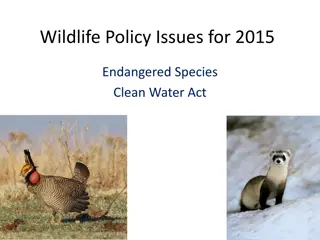Animal Classification: Mammals, Birds, Reptiles, Fish, and Amphibians
Explore the world of animal classification through 5 distinct groups - mammals, birds, reptiles, fish, and amphibians. Discover what sets each group apart, from their bone structure to unique characteristics like fur, beaks, scales, and more. Engage in activities to identify and understand the featu
11 views • 4 slides
Amphibian Parental Care and Protection Methods
Parental care in amphibians involves various strategies such as nest building, direct carrying of eggs, and protecting developing eggs in different ways like laying eggs on leaves, burrowing, or creating foam nests. These methods ensure the survival of amphibian species by providing a safe environme
0 views • 11 slides
Comparing Groups of Vertebrates: Features and Differences
Explore the key characteristics of five groups of vertebrates - mammals, birds, reptiles, amphibians, and fish - including details on blood type, offspring, skin, and breathing apparatus. Learn about the unique traits that distinguish these vertebrate groups from one another.
0 views • 4 slides
Comparative Analysis of Vertebrate Brains: From Cartilaginous Fish to Amphibians
The brain in vertebrates varies in size and complexity, with distinct structures like the prosencephalon and mesencephalon. From cartilaginous fishes with large olfactory lobes to bony fishes with specialized brains, the evolution of brain structures can be observed. Amphibians, like frogs, show uni
1 views • 12 slides
Aquatic Adaptation in Animals
Aquatic adaptation refers to the changes in an animal's body organization to thrive in a water habitat. Vertebrates have evolved to lead partial or total aquatic lives, showcasing various adaptations. Water as a habitat offers a homogenous medium, stable conditions, and rich food resources. Aquatic
1 views • 9 slides
Diverse Parental Care in Amphibians - An Insightful Overview
Amphibians, including anurans, urodelans, and apodans, exhibit a variety of parental care strategies to protect their eggs and offspring. From nest construction to direct nursing, different species showcase unique behaviors to ensure the survival of their young. Explore the fascinating world of pare
0 views • 34 slides
Amphibian Metamorphosis: A Dive into Developmental Changes
Amphibian metamorphosis marks the transition from larval aquatic life to adult terrestrial existence. The process involves morphological transformations including tail resorption, gill destruction, and skin structure changes. Key changes in urodeles (salamanders) and anurans (frogs/toads) are outlin
1 views • 6 slides
Vertebrates Final Review - Study Guide with Images
Explore the world of vertebrates with this comprehensive final review. Learn about chordates, fish, amphibians, reptiles, birds, and mammals through informative images and questions. Test your knowledge on topics like excretion, respiratory organs, locomotion, and anatomical features unique to chord
0 views • 74 slides
Wildlife Policy Issues for 2015: Endangered Species & Clean Water Act
Overview of policy issues surrounding endangered species and clean water act in 2015, including definitions, history, causes of endangerment, petition and listing factors. Focus on protecting species like the Lesser Prairie Chicken and Black-footed Ferret. Mention of Kansas' threatened and endangere
0 views • 21 slides
Differences Between Frogs and Toads: Explained with Images
Frogs and toads belong to the Amphibia class but have distinct characteristics. Frogs are known for their bulging eyes and smooth skin, while toads are recognized by their warty, dry skin. Despite similarities in life cycles, specific features differentiate the two. Both can be found worldwide, exce
0 views • 16 slides
Frog Care Guidelines and Licensing Information in Victoria
Understanding the regulations around caring for frogs in Victoria is crucial. Frogs are amphibians that require a license for captivity, with specific species listed for licensed and unlicensed ownership. Providing a stress-free environment and considering the long lifespan of some species are essen
0 views • 6 slides
Plant Kingdom Diversity and Characteristics
Explore the intriguing world of the plant kingdom through topics like classification by notable scientists, gamete characteristics in Phaeophyceae, unique features of Bryophytes, and the significance of Bryophytes as the amphibians of the plant kingdom. Delve into the structures and functions of pla
0 views • 21 slides
The Fascinating World of Insects and Animal Classification
Discover the unique characteristics of insects such as their body parts, legs, compound eyes, antenna, and exoskeleton. Learn about the classification of animals into insects and non-insects, as well as vertebrates and invertebrates. Explore how animals can be sorted based on different criteria and
0 views • 35 slides
Herpetology: Reptiles, Amphibians, and Their Fascinating World
Delve into the captivating realm of herpetology, the study of reptiles and amphibians. Discover the characteristics of these cold-blooded vertebrates, from scaly reptiles to slimy amphibians. Uncover the similarities and differences between these two groups, their reliance on water, and the rich div
0 views • 22 slides
Animal Classification WebQuest: Dive into the World of Vertebrates!
Discover the fascinating world of animal classification with the Animal Classification WebQuest presented by Joseph Jackson. Learn about the five categories of vertebrates - mammals, reptiles, birds, fish, and amphibians. Dive into tasks like identifying animals, completing worksheets, playing games
0 views • 12 slides
Training Module on Laboratory Animals in Biomedical Research
This training module focuses on the utilization of laboratory animals in biomedical research, covering various species such as rodents, rabbits, birds, amphibians, and more. It emphasizes understanding different animal models, controlling experimental variables, and outlining responsibilities within
0 views • 34 slides















